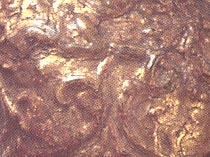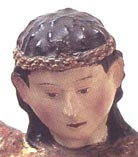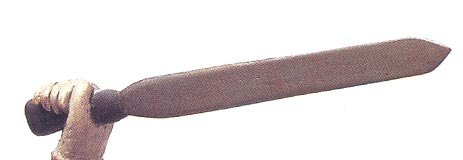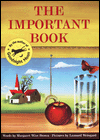
Introduction/Overview:
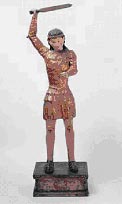 St. Michael the Archangel, 16th/17th century |
This lesson will begin with an examination of the exhibit piece, St. Michael the Archangel. The concept of heroism and heroic deeds will be explored. Students will complete research on heroes and conclude by creating a narrative composition about a hero and his/her actions. This sculpture blends two cultures; the technique used is typical of the indigenous people of Mexico, but the subject is Roman Catholic. The clergy converted the native peoples of New Spain with tremendous missionary zeal. Part of this process involved adapting their ancient worship and art forms to a new purpose, that of glorifying the church. |
Artistic technique:
This sculpture was molded from a paste made of pounded corn husks mixed with certain natural plant adhesives, then it was gilded and painted. This technique was indigenous to colonial Mexico and enabled the production of statues that were very light weight in spite of their size. This sculpture also features parts carved out of colorin wood which is porous and light. It was common to use both corn cane paste and colorin wood together because of their relative lack of weight.
The indigenous artist simplified and stylized the form of St. Michael, and his head is relatively small in proportion to his body. The artist paid great attention to the detail of the armor, possibly copying ornamentation found on military garb.
More about St. Michael:
One of the most powerful engines of change in New Spain was the Roman Catholic church. Here, the church is represented by the figure of St. Michael the Archangel. He stands clad in golden armor, his sword raised in triumph. According to the New Testament, Michael drove Satan out of heaven. To Roman Catholics, he was seen as the protector of the Church.
Learning Objectives:
Students will
- identify characteristics of a hero
- write a narrative composition describing a heroic event
Suggested Activities/Procedures:
1. Set Background and purpose
a. Show students the sculpture St. Michael the Archangel. Discuss the significance of his name, from the Hebrew meaning, "Who is like God?" St. Michael is noted as the guardian against evil forces. In scripture, he is considered the symbol of Good vs. Evil.
Link to the exhibit: http://www.fm.coe.uh.edu/exhibition/stmicheal/cultures_michael.html (link opens new browser window)b. St. Michael was a hero in Roman Catholic beliefs and to the people of Vice Regal Mexico.
c. St. Michael is the Patron Saint of grocers, mariners, police, firefighters and paramedics
d. Relate his role as Patron Saint to the modern day heroes of September 11, 2001.
2. Brainstorming
a. Brainstorm the definition of a hero. Check meaning in dictionary: (hero n: a person of great courage, nobility, etc. or one admired for his/her deeds and exploits.)
b. Look at the sculpture and discuss the stance of St. Michael. How does the artist convey the concept of St. Michael as a hero in his work? (raised arm with weapon, confident stance, intense look on face)
3. Prewriting activities
a. Show students Web sites:
http://www.myhero.com/homeintro.html or http://library.thinkquest.org/C001515/ to start them thinking about what makes a hero.(link opens new browser window)
Alternate activity:
Read a book or article about someone that you consider a hero. Have the students select books about heroes.b. Have students brainstorm a list of people they see as heroes. Divide the list into heroes past and heroes present
c. Looking at the list, have the class brainstorm characteristics of a hero. Identify the characteristics that the people on the list possess. (Note: Through this discussion, guide the students into seeing that having wealth, beauty or popularity does not necessarily cause them to be heroes.)
d. Students can access the following Web site to learn about heroes of the 20th century: http://library.thinkquest.org/C001515/design/ (link opens new browser window)
4. ComposingGive the students the following story prompt and planning sheet:
"Many people are considered to be heroes. Write a story telling about a hero. Tell what he or she did that made him a hero. You may write a story about something that really happened or something that you make up. Be sure to tell about the events of your story in detail."5. Revision
Students will use available materials to revise their piece for word choice, organization, voice and sentence structure.
6. Editing
Students will edit piece for spelling, capitalization and punctuation. (Conventions)
7. Publishing
Students will complete a final copy of their story for grading.
Extending the Lesson:
Students with limited background or limited English proficiency:
- Read aloud The Important Book by Margaret Wise Brown.
- Talk about the topic "The important thing about being a hero…"
- Have the class work in cooperative groups to create pages for a class book about heroes patterned after Wise's book.
Online resources about Margaret Wise Brown and her books:
http://www.ncws.com/btdart/MWB.htmAdvanced students could complete any of the following extensions:
- Create a poster advertising your hero for the award "Hero of the Year."
- Write a research report on a hero of your choice
Reference and links: http://library.thinkquest.org/C001515/design/ (link opens new browser window)- Create a brochure for a charitable organization founded by your hero.
- Design a web page honoring your hero.
(Reference: http://myhero.com/New_Create/create1_table.asp (link opens new browser window)- Make a picture dictionary of qualities exhibited by heroes.
- Project cards for the above activities in PDF format (download the free Acrobat Reader to view)
Time Required:
1 week
Curriculum Standards:
National Council of Teachers of English (NCTE)/International Reading Association (IRA)
4. Students adjust their use of spoken, written, and visual language (e.g., conventions, style, vocabulary) to communicate effectively with a variety of audiences and for different purposes.
5. Students employ a wide range of strategies as they write and use different writing process elements appropriately to communicate with different audiences for a variety of purposes.
6. Students apply knowledge of language structure, language conventions (e.g. spelling and punctuation), media techniques, figurative language, and genre to create, critique, and discuss print and non-print texts.
Texas Essential Knowledge and Skills (TEKS)
TEKS (4.13)(5.13) Reading/inquiry/research. The student inquires and conducts research using a variety of sources.
TEKS: (4.15) (5.15) Writing/purposes. The student writes for a variety of audiences and purposes and in a variety of forms.
TEKS: (4.19) (5.19) Writing/writing processes. The student selects and uses writing processes for self-initiated and assigned writing.
TEKS: (4.16) (5.16) Writing/penmanship/capitalization/punctuation. The student composes original texts, applying the conventions of written language, such as capitalization, punctuation, and penmanship, to communicate clearly.
Evaluation/Assessment: Use the 6 Trait +1™ Model to assess compositions.
Assessment rubric in PDF format (download the free Acrobat Reader to view)
Tips for the Teacher:
- Brainstorming sessions on heroes and characteristics of heroes may be conducted in small cooperative groups and shared with the class as oral presentations.
- The 6 Trait Model
- Information
on 6 Trait +1 Writing™ and assessment:
http://www.nwrel.org/assessment/about.asp?odelay=1&d=1 (link opens new browser window) - References
of books to help teaching 6 Traits:
http://6traits.cyberspaces.net/books.html (link opens new browser window)
- Information
on 6 Trait +1 Writing™ and assessment:
- Books
for setting background (link opens new browser window)
Student Materials:
Student planning sheet in PDF format (download the free Acrobat Reader to view)

